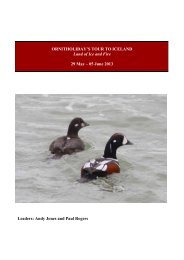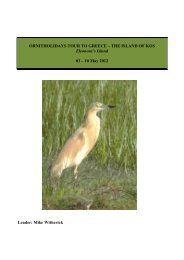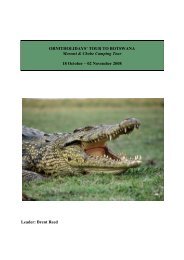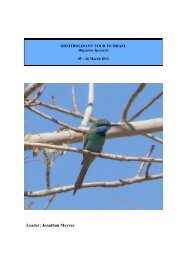Download 2014 Brochure (.pdf) - Ornitholidays
Download 2014 Brochure (.pdf) - Ornitholidays
Download 2014 Brochure (.pdf) - Ornitholidays
You also want an ePaper? Increase the reach of your titles
YUMPU automatically turns print PDFs into web optimized ePapers that Google loves.
S PA I N<br />
Sawfly Orchid<br />
Egyptian Vultures<br />
Coastal scrub is likely to turn up a variety of<br />
migrant warblers and flycatchers; while<br />
European Bee-eaters and Golden Orioles may<br />
arrive during our stay. Woodlands of Aleppo<br />
Pine, Holm Oak, Olive and Lentisc (a relative of<br />
Pistachio) hold populations of resident Firecrest,<br />
with both Wood and Western Bonelli’s Warblers<br />
passing through. Red-rumped Swallows are<br />
regular among the other hirundines. The<br />
seasonal wetlands of Tirant are in the north of the<br />
island. Since all the migrants filter through<br />
towards the north it may well repay us to make<br />
two visits to look for waders, ducks, and perhaps<br />
the odd stork or unusual raptor. The rocky<br />
promontaries of the north coast hold good<br />
populations of Thekla and Greater Short-toed<br />
Larks.<br />
Raptors are a special feature of the island. The<br />
Booted Eagle numbers about 60 pairs, a huge<br />
number for such a small island. Egyptian Vultures<br />
have over 30 pairs, and the declining Red Kite<br />
hangs on, with about 10 pairs. Peregrines nest on<br />
the cliffs; while Eleonora’s Falcons (which nest on<br />
nearby Majorca) are sometimes seen passing by<br />
in spring. A few pairs of Ospreys nest too, and<br />
often fish offshore. Western Marsh Harriers are a<br />
regular sight in spring; and we shall keep our<br />
eyes open for other migrants such as Montagu’s<br />
Harrier, Eurasian Hobby and Red-footed Falcon.<br />
Common Ravens are the only corvid on Menorca,<br />
and share the scavenging duties with kite and<br />
vulture. Offshore, Cory’s (Scopoli’s) Shearwaters<br />
wheel over the waves and often join feeding<br />
frenzies with the gulls. Menorca is a stronghold<br />
for this large, slow-flying shearwater. The island is<br />
also important for the rare Balearic Shearwater.<br />
On Menorca, Pallid Swifts nest in small colonies<br />
along the cliffs (as well as in some coastal<br />
towns). Alpine Swifts have a coastal colony too.<br />
Blue Rock Thrushes also reach their greatest<br />
density in clifftop sites. The beauty of being a<br />
small island surrounded by sea is that it<br />
increases the chance of visits by over-flying<br />
migrants. If weather conditions are suitable we<br />
may be treated to some large falls of Pied<br />
Flycatcher, Common Redstart, Whinchat, Willow<br />
Warbler, Blackcap, Barn Swallow, Sand Martin<br />
and perhaps even a Wryneck or two. There is<br />
always the chance of something unusual turning<br />
up: perhaps a Collared Pratincole or a Garganey<br />
in the wetlands; maybe a Spotless Starling or<br />
Rufous-tailed Rock Thrush in the rock-strewn<br />
fields; or perhaps a Dartford Warbler or Western<br />
Orphean Warbler in the bushes.<br />
In addition to the birds, flowers and butterflies we<br />
will spend a little time in the capital Mahon,<br />
whose natural harbour is reckoned to be the<br />
finest in the Mediterranean. A short cruise will<br />
offer good views of the city as well as a chance<br />
to see Peregrine Falcon. Along the seafront,<br />
Audouin's Gulls can often be persuaded to feed<br />
on scraps of bread at our feet – a photographer's<br />
joy. Menorca also has a unique series of Bronze<br />
Age sites, left behind by the Talayotic civilization,<br />
from 1400 BC onwards. They feature many<br />
talayots (rocky mounds for defence and<br />
observation), taulas (T-shaped henges that were<br />
probably astronomical observatories) and<br />
navetas (burial chambers). These mysterious<br />
places are always great botanical sites and often<br />
interesting for birds too.<br />
Day 8<br />
Today we have time for further exploration before<br />
we catch our direct evening flight to London or<br />
regional airports (where available) where the tour<br />
ends.<br />
Outline Itinerary<br />
Day 1 Fly to Mahon and transfer<br />
to Matchani Gran<br />
Days 2-7 Matchani Gran<br />
Day 8 Depart Mahon<br />
Party Size<br />
Maximum of 14 clients (two leaders with<br />
more than seven clients).<br />
Accommodation<br />
Comfortable accommodation in twin/double<br />
and single rooms with private facilities.<br />
Lunches are mostly picnics, with some<br />
lunches at Matchani Gran.<br />
Transport<br />
By minibuses driven by the leaders.<br />
Includes<br />
All flights, meals, accommodation, transport,<br />
entry fees, services of the leaders, VAT,<br />
airport taxes and tips.<br />
Gradings<br />
Good<br />
90<br />
Warm to Cool<br />
Low<br />
Normal<br />
Relaxed<br />
Good<br />
Easy<br />
Scheduled<br />
Matchani Gran<br />
To make a booking please call <strong>Ornitholidays</strong> on 01794 519445<br />
105








